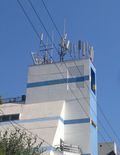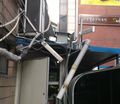When you perform a manual network search in the UK today, you'll see 5 networks on the display. They are in no particular order:
- O2
- Vodafone
- T-Mobile
- Three
- Orange
But in fact with the recent decision of the UK regulator to allow network sharing between Vodafone and O2, there are a mere two mobile networks left in the UK. And non of the above mentioned 5 companies are actually operate one of those networks anymore. And here's why:
T-Mobile and Orange have merged and are soon going to be re-branded Everything Everywhere (EE) for consumers as well. From what's in the press they have already begun to put their network together, which reduces the number of companies to 4.
And then there's the UMTS network sharing deal between EE (form the T-Mobile side) and Three UK in a common company called MBNL (Mobile Broadband Network Limited). On their web page they write:
"Having successfully delivered the consolidation project, MBNL is now responsible for managing the consolidated network of sites including the 2G and consolidated 3G radio access networks for Three UK and Everything Everywhere. We are also responsible for the delivery of all site upgrades to continuously improve the consolidated network."
So we are down to three, i.e. MBNL, Vodafone and O2. But now Vodafone and O2 have been allowed to share their network as well, perhaps to 'compensate' the two companies for EE's early LTE start in the 1800 MHz band? As part of the network sharing agreement, Vodafone and O2 will establish a new network operator called "Cornerstone" that will manage and operate their consolidated network.
In other words, in the future there will only be two networks left in the UK:
- MBNL
- Cornerstone
I really wonder how under such circumstances competition will continue to flourish!?
In effect, Vodafone will be unable to differentiate from O2 and EE has no real means to differentiate from Three. They all claim that using their own spectrum will keep competition alive but I strongly doubt that. After all, everything is shared, from the antennas, to the base station to the backhaul. Only core networks will remain in the hands of the 4 'hollow operators'. So what for example if one gets a capacity issue in some locations? If the company had its own base station it could simply add a carrier. But that won't work so easily now because the base station and backhaul is shared. Is there enough capacity and room left for another carrier? Also, putting another base station into place close by will be difficult as the partner that shares the network might not want to do that. Perhaps putting micro base stations somewhere under direct control of the parent? Again difficult because neighbor cell relationships and handovers need to be coordinated. No, probably not possible with a shared network either. And even without that the bill is likely to come later when 'real' network operator asks for more money after the contract expires.
So it's down to two networks in the UK and it's going to be difficult to impossible to revert that trend if things don't work out for the consumer. A hazardous and unnecessary experiment…






